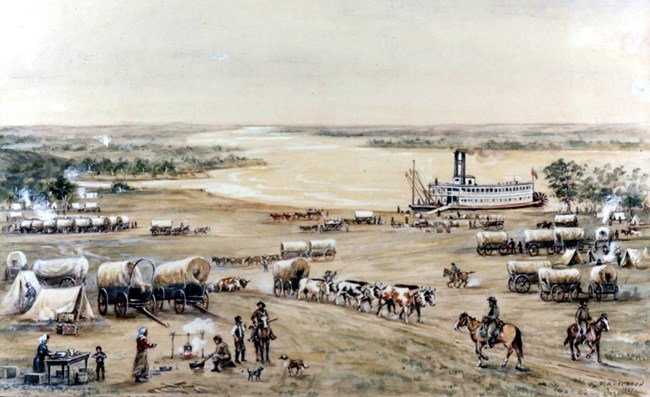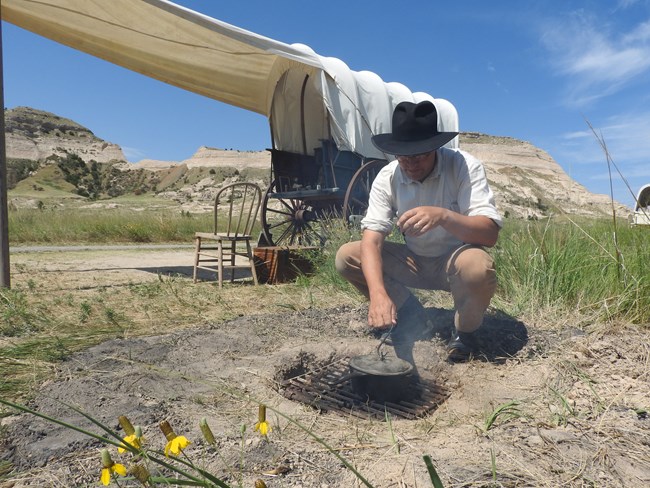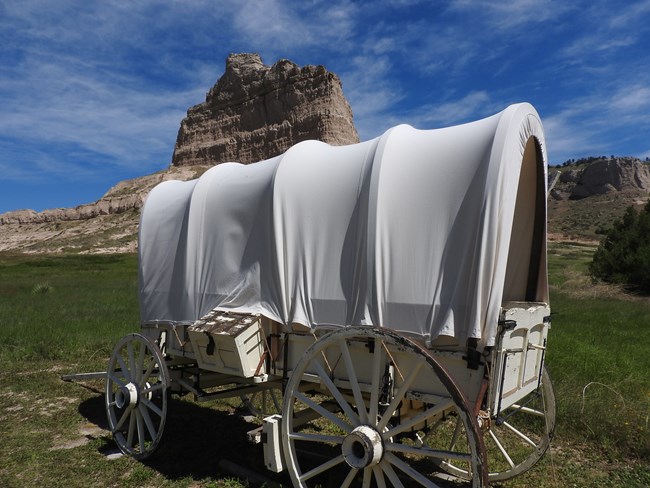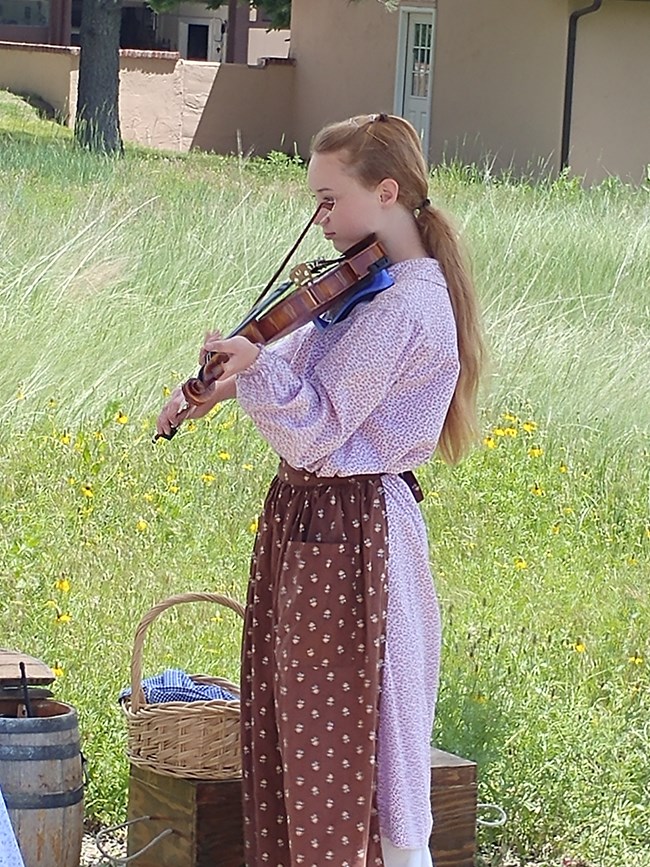Part of a series of articles titled The Emigrant Experience .
Article
Traveling the Emigrant Trails

The Scotts Bluff National Monument William Henry Jackson Collection
A New Beginning
Emigrants would start to gather at one of the "jumping-off places" along the Missouri River in early April. These "jumping-off" towns included Independence and St. Joseph, Missouri. Everything an emigrant needed could be found in these towns: tools, food, wagons, and animals were for sale. Even trail guides could be hired. Favorite pieces of furniture were left behind to make room for plows, seeds, food, tools, and other necessities. Before the wagon train left, they typically elected a captain to lead the way. Many emigrants said a fond farewell to their families for the last time and set off on their journey when the grass started to green, typically mid April.The Oregon Route
The wagon train needed to leave on time because the trails were full of dangers and setbacks, such as lack of grass for their livestock and mountain snows. From Independence, Missouri, the trail folowed the Little Blue, Platte, Sweetwater, Snake, and Columbia Rivers through Kansas, Nebraska, Wyoming, Idaho and Oregon. Emigrants typically traveled 12 to 15 miles per day and it took 4 to 6 months to travel the 2,000 miles.
NPS
A Typical Day
- Around 4 am the wagon leader sounded the trumpet or fired a rifle to wake everyone up.
- By 5 am breakfast was prepared, while the animals were rounded up after a night of grazing.
- By 6 am the men and boys hitched the wagons while everyone else ate breakfast.
- At 7 am the bugle sounded, the wagonmaster shouted "Wagons roll!", and the emigrants started off for the day.
- There was an hour lunch break, referred to as "nooning".
- At around 6 pm the wagons were circled. Circling the wagons wasn't for protection against the Indians as much as it was to provide a corral for livestock, and security from cattle thieves, wild animals, and weather. Immediately, campfires were started and dinner was cooked.
Supplies
In 1850, it cost roughly $800 to $1,200 to obtain a proper outfit and get by for a whole year without harvesting a crop. In 2025 dollars, this would be equivalent to $32,000 to $48,500. The Emigrant's Guide by Joseph Ware, published in 1849 in St. Louis, suggested the following supplies for three people headed west on the Oregon Trail:Food: Flour (1,080 lbs), bacon (600 lbs), coffee (100 lbs), tea (5 lbs), sugar (150 lbs), rice (75 lbs), dried fruit (50 lbs), salt and pepper (50 lbs), saleratus (baking soda) (10 lbs), and lard (50 lbs). Also corn meal, hard-tack, dried beef, molasses, vinegar, eggs, and beans.
Tools and equipment: Plow, shovel, rake, hoe, carpentry tools, saw, mallet, ax, plane, spade, whetstone, axles, kingbolt (joins the body of a wagon to its front axle), ox or mule shoes, spokes, ropes and chains.
Cooking utensils: Oven, skillet, kettle, coffee grinder, teapot, knife, ladle, tin tableware, water keg, and matches.
Seeds: Corn, wheat and other crops.
Weapons: Rifle, shotgun, pistols, knife, hatchet, powder, lead, bullet mold, powder horn, bullet pouch, and holster.
Clothing: Wool coats, rubber coats, cotton dresses, buckskin pants, duck trousers, cotton shirts, woolen undershirts, cotton drawers, flannel shirts, cotton socks, boots, shoes, ponchos, felt hats and sunbonnets.
Bedding and tents: Blankets, ground cloths, pillows, tent, poles, stakes, ropes.
Luxuries: Canned goods, plant cuttings, books, musical instruments, dolls and toys, family albums, jewelry, China, silverware, fine linens, iron stoves and furniture.
Miscellaneous items: Surgical instruments, liniments, bandages, camp stool, chamber pot, washbowl, lanterns, candle molds, tallow, spyglasses, scissors, needles, pins, thread, toothbrushes, soap, comb, brush, and towels.
Resupply
No matter how prepared the emigrants were at the start of their journey, they were always in need of new supplies. A lot of these supplies came from frontier forts along the trail. Forts and trading posts were set up to help supply wagon trains and to help protect them along their journey. The forts would supply the emigrants, often at a high price; with wagon parts, tools, food, clothes, and other essential supplies. The forts were also a good place for the emigrants to sell any excess supplies. However, if the fort traders were not buying, many supplies had to be discarded. The forts also provided a safe place to relax.Wagon Teams: Oxen vs. Mules


Left image
Mules
Credit: NPS
Right image
Oxen
Credit: NPS

NPS
Wagons
To outlast the rugged trails, wagons needed to be constructed of seasoned hardwood, such as maple, hickory, or oak, and carry up to 2,500 pounds. The three main parts of the wagon were the bed, undercarriage, and cover. They were approximately 10 feet long and 4 feet wide. Wheels had to be extremely tough and were usually made of osage orange wood or white oak. The average wagon cost approximately $85 and the cover around $100.
NPS
Leisure Time
Rarely did the pioneers take time off to celebrate. However, people did get married, have babies, and celebrate birthdays. The Fourth of July was a holiday most emigrants celebrated along the trail. In the evenings, the emigrants played cards, chess, checkers, and other lightweight games. They also mended clothes, wrote letters and fixed wagons. Children played Button, Button or Drop the Handkerchief. Some brought violins or other musical instruments to play.Food on the Trail
The emigrants supplied themselves with flour, beans, bacon, potatoes, biscuits, dried fruit, jerky, and coffee. Meat included venison, buffalo, beef and wild birds if hunting was successful. Leftover meat made stew for the next day. Fat drippings from the meat were mixed with flour to make gravy. In desperate times pioneers cooked snakes or prairie dogs. If they brought a milk cow they could churn butter by taking advantage of the swaying wagon. If wood was not available on the plains, fires were fueled with "buffalo chips."Trail's End
With little money or supplies left, the pioneers cleared rocks and cut trees to build their new homes. The first winter was difficult for the new settlers. Once spring arrived, they found that their hard work and journey west had been worthwhile. Oregon had forests, rich soil, and wild game. California had warm weather and good growing climates for crops. Soon, the western settlements were becoming towns. Businesses were started as more emigrants arrived. Most began to enjoy the comforts they had missed.Last updated: April 29, 2025
